The Imagination of an Aesthetic Regime in the Modern Arab City: Dissent, Redistribution of the Sensible, Poetics
The Arab city has been surrounded by dissensus for the past decade. It is high time to review this dissent, which, I argue, is ongoing, through the lenses of planning and architecture, revisiting the architectural and urban discourses within which the imagination of the Arab city is embedded. It regards the city as a productive space rather than solely as a category or a field of study and maps out various active agents in the production and shaping of an aesthetic regime for the Arab city of today. This is achieved through an examination of certain aspects of post-independence planning in the Arab world and by analysing both the discourse disseminated by the Arab Towns Organization (ATO) and the associated aesthetic regime as anticolonial, political tools.
By dissecting collective and individual acts connected to this aesthetic regime, its textual and its visual ‘language’, this paper effects a reconsideration of the positioning of its architects and urban planners within the political landscape. The paper starts with (and is subsequently structured by) a theoretical discussion of a specific aesthetic regime that is linked to the imagination of the Arab city and attempts to understand the rise of this regime as a decolonizing tool. Taking a 1979 newspaper article featuring ATO as a point of entry into a conversation about the early formations of the modern Arab city, it then proceeds to redraw this city as a productive space of dissent within which to rethink and reimagine its own formation. The paper then presents an analysis of the new distribution of sensibilities in the city. Finally, the paper showcases the ‘poetics of space’ of several projects designed by the architect Mohamed Makiya that are connected to ATO among other Pan-Arab organizations.1
Jacques Rancière’s work on the aesthetic regime resonates with me and affords me with the means to unpack this intertwinement of space and politics. I arrive here through the work of Mustafa Dikeç, who interprets Rancière’s writings on aesthetics alongside those of Jean-Luc Nancy and Hannah Arendt in order to understand the politics of spaces within cities.2 Rancière claims that aesthetics is:
subject neither to the law of understanding, which requires conceptual determination, nor to the law of sensation, which demands an object of desire. Aesthetic experience suspends both laws at the same time. It therefore suspends the power relations which usually structure the experience of the knowing, acting and desiring subject.3
I agree with this statement, which I would reformulate to claim that aesthetic experience can suspend and override pre-existing sensations and desires. Put either way, this usefully stakes out some of the common ground that is held between aesthetics and politics. The promise of a new poetics speaks to and can reorganize our sensibilities. The ruptures formed by encounters with aesthetic newness do not necessarily have to be grand or violent moments of change. They can occur delicately (as when engaging with a subtle art installation) and still provoke us to think and feel in new directions.
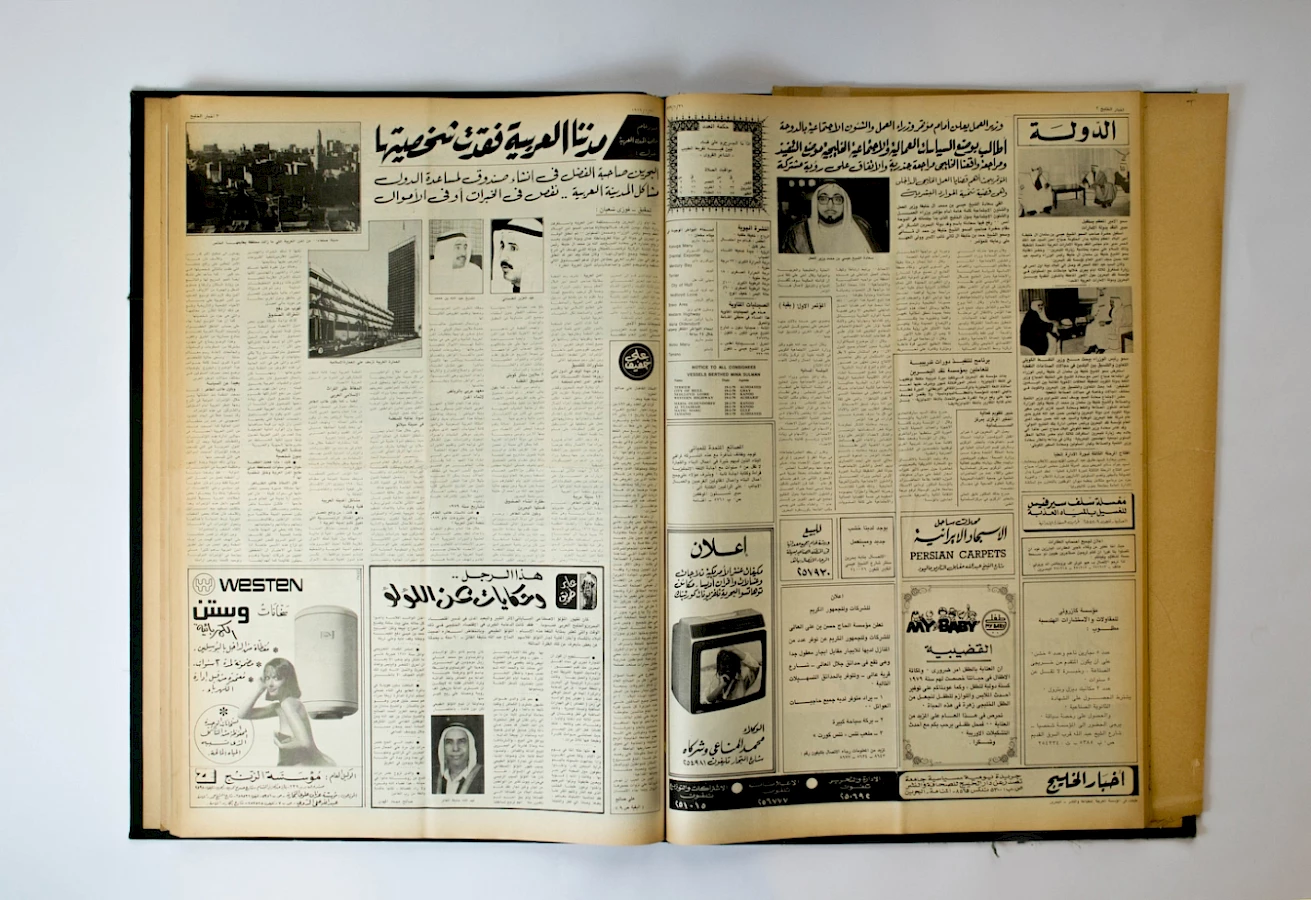
Figure 1. Article entitled "Our Arab Cities Have Lost Their Identity" by Fawzi Shabaan in Akhbar Al Khaleej (21 January 1979). Image by Mohammed Adwan.
As mentioned earlier, this paper is structured around my reading and translation of a newspaper article entitled ‘Our Arab Cities Have Lost Their Identity’ by Fawzi Shabaan, published in Akhbar Al Khaleej on 21 January 1979 (see figures 1 and 2). Each line of the translation has been numbered according to a process of discourse analysis that is used in linguistics and social studies, providing the reader with precise references to the text in their full context.4 Thus, whenever line numbers are mentioned within the text these refer to those of my translation (figure 2). In conducting the translation, I have attempted to convey the meaning as fully as possible rather than rendering the translation word-for-word. Occasionally Arabic verbs and nouns are placed in a different and deliberate manner to create a dramatic effect, a literary technique which does not always translate well into English, for example. I will touch upon issues of language again.

Figure 2.1. Translation of article entitled "Our Arab Cities Have Lost Their Identity" by the author.
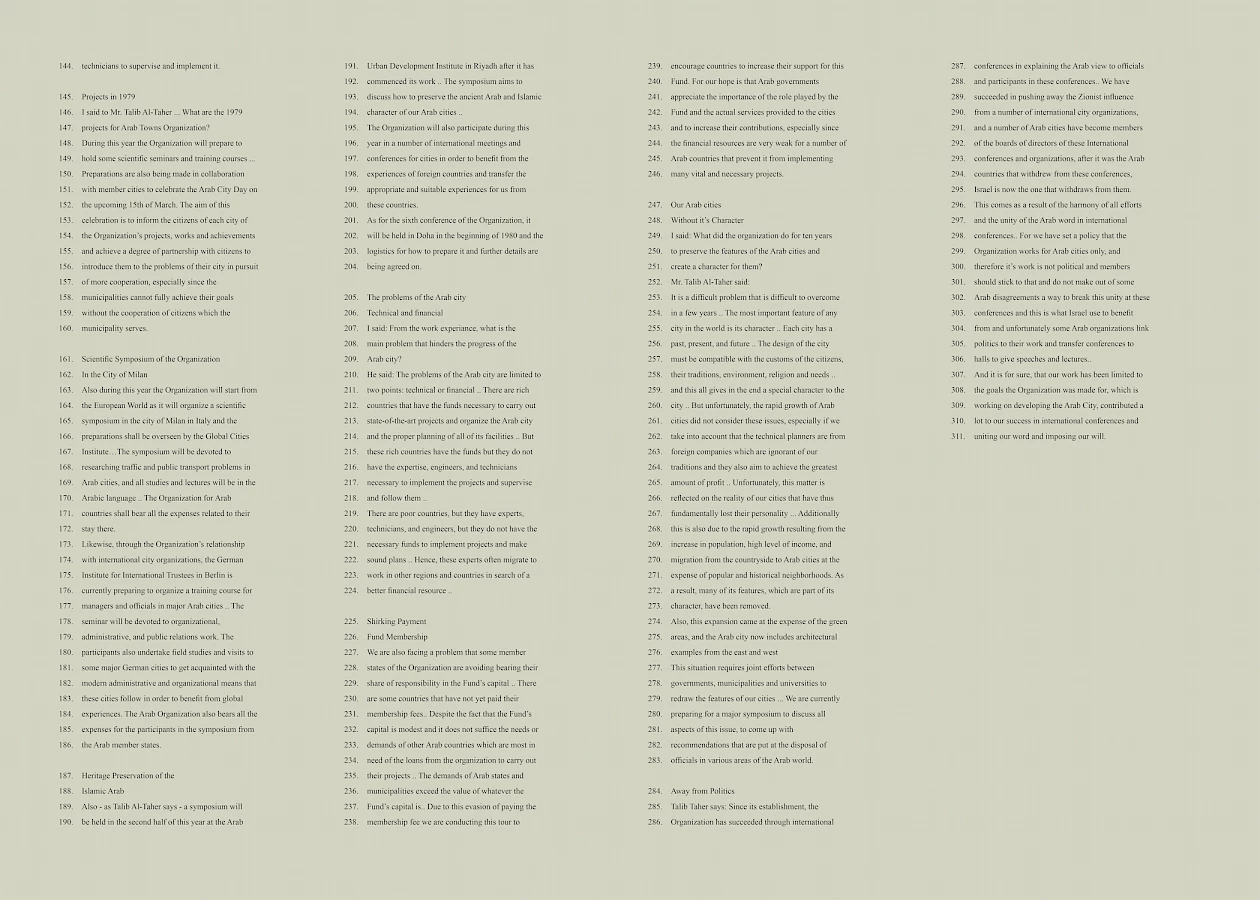
Figure 2.2. Translation of article entitled "Our Arab Cities Have Lost Their Identity" by the author.
The Aesthetics of Coloniality
The participants also undertake field studies and visits to some major German cities to get acquainted with the modern administrative and organizational means that these cities follow in order to benefit from global experiences (lines 179–84).
Colonialism enabled the project of modernity in the West and paved the way for the emergence of coloniality (a term attributed to Aníbal Quijano).5 The continuing-to-function after independence of bureaucratic, legal, educational and other governing systems established by the colonizers has,6 Quijano argues, reshaped the world of today, re-organizing the distribution of resources and structures within societies and, perhaps more drastically, their sensibilities, thus limiting and constraining the ability of these societies to imagine. This continuation of the domination of colonialism through the domination of the imagination is coloniality.7
The emergence and creation of independent states as modern nations, as opposed to a return to what predated nationalism, was symbolised by a national flag raised high. But the system of the colonizer was not altered: there was simply an exchange of power into the hands of local actors, who were many times the same enablers of the colonizer’s exploitation. The imagination of the new nations came to be dominated by what had become global systems of trade and diplomacy, and by the constraints of rhetorics of nationalism – thus, Walter D. Mignolo advocates for delinking from the centres of global power as a precondition for true independence.8 The nation-building project is one in which the new leaders will attempt to rewrite the nation’s history through selective suppression.9 This requires a new mode of visual representation, a new aesthetics for the cityscape that aligns with this history. Interestingly, references to pre-colonial times may be invoked in the attempt to communicate the identity of the newly independent nation state, and with the passage of time the aesthetic productions of colonial times transform into national heritage in need of preservation. The post-colonial city thus comes to represent the narrative of the new governing system.10 This narrative supports a single story of the nation, drawing from its ancient history and avoiding its more recent history – the latter constituting what Achille Mbembe terms the demons of nations.11 In the case of previously colonized states this includes the trauma that resulted from colonization as well as the silencing of groups that pose a threat to the homogeneity of the nation state.
In the process of decolonization, the countries that formed the Arab League started to form a homogeneous entity in many of whose cities Arabic became the only language that was permitted to be spoken. Even while other identities and languages were removed from the landscape, the visual language of their architecture was appropriated and recoined as part of an Arab visual language. The solidarity required for and between anti-colonial movements inadvertently dictated that a single identity was to be shared amongst these cities.
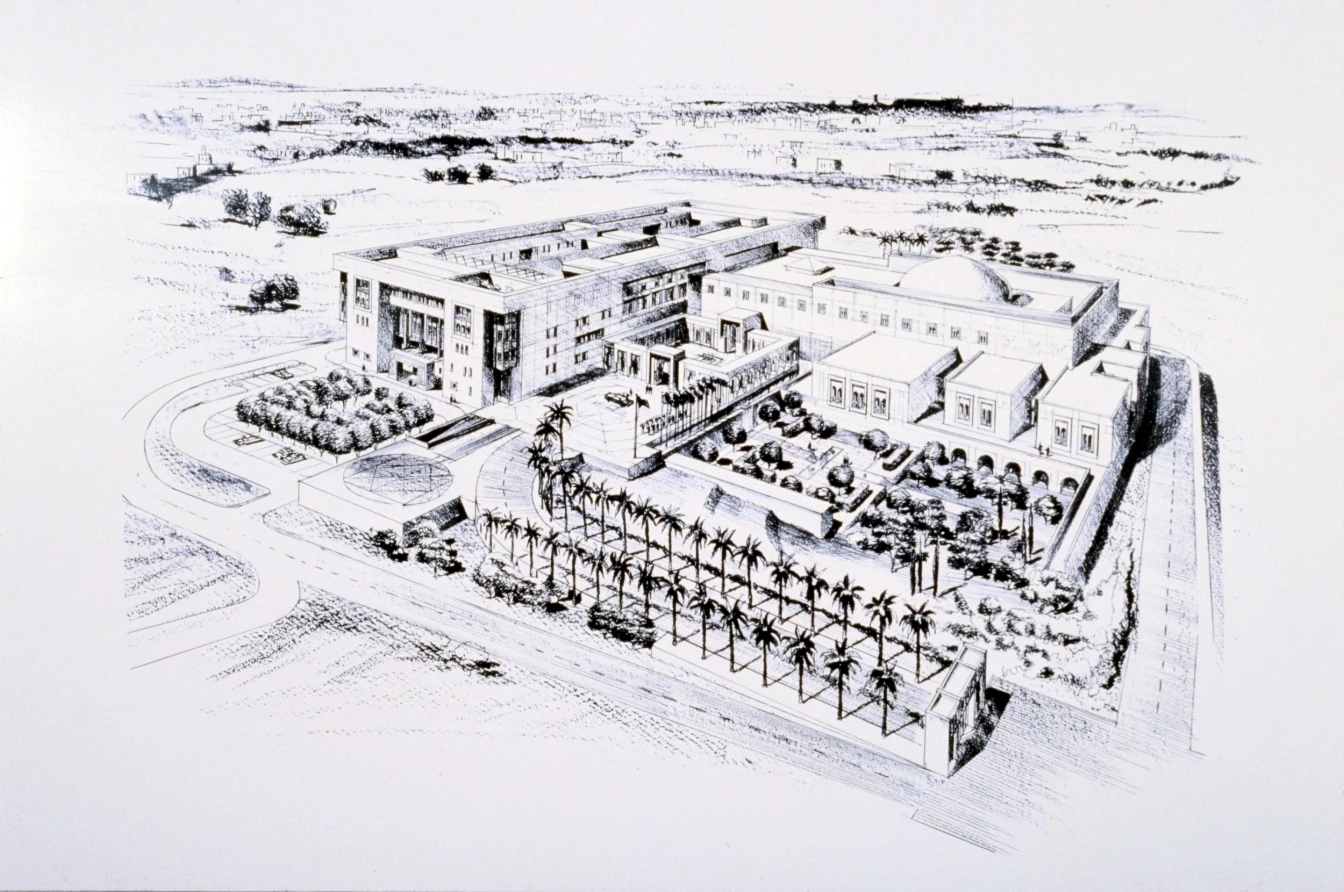
Figure 4. Sketch of the League of Arab States [unbuilt], Tunisia. Mohamed Makiya (ca. 1984). Image credit: Mohamed Makiya Archive, courtesy of Aga Khan Documentation Center, MIT Libraries (AKDC@MIT). https://www.archnet.org/collections/123
The Dissent of the Arab City
… encouraged us in our mission and activities related to the development of Arab cities and the preservation of their Islamic character (lines 32–36).
The question of the character of the city in the Arabic-speaking world is a complex one due to the diversity of these cities for which the terms ‘Arab’ and ‘Islamic’ are often used interchangeably. Nonetheless, this paper acknowledges that the dominating aspect of the Arab city is rather a hegemonic Arab identity – which, I argue, is imagined. The imagination of national identities is discussed at length by Benedict Anderson, who attributes the imagination of national consensus to the print-capitalism through which language and its dissemination through publication produce new allegiances.12 It is therefore not surprising that the Arab and Islamic identities are intertwined, given their uniting mode of communication. Throughout its history the character and appearance of the modern Arab city has been closely tied to print media’s production of spaces for the consolidation of power and of a condition of continuous dissent from which new systems have emerged.
According to a 1954 Foreign Office report, one of the earliest instances of an Arab nationalist project occurred in 1805 when Mehmed Ali came to power in Egypt during the Ottoman Empire.13 The report states that his Egyptian nationalist project had failed to appeal to the masses, attributing this to then-widespread illiteracy in addition to his being of Albanian descent. Khaled Fahmy critiques Mehmed Ali’s attempt to build an Arab Empire on the basis that he spoke no Arabic.14 Contrast the contributions made to the rise of Arab nationalism as a political movement by intellectuals such as Rifa'at Tahtawi, Jamal Al-Din Al-Afghani, and Mohammed Abdu, who, influenced by their experiences in France and the ideas of modernity they encountered there, used written media to share their ideas in Arabic-speaking countries.15 Rifa'at Tahtawi specifically wrote a book on Paris, providing a detailed account of the city and comparing it to Egypt.16 While this book and its effect are often cited in relation to modernity and education in Egypt and the Arabic-speaking world, I have yet to encounter an assessment of its influence on urban planning.
It was in this context that a new aesthetics was to emerge in the newly postcolonial Arab region where, it is important to note, the Ottoman Empire had also figured as a colonial power. The use of the word ‘Arab’ thus served to emphasise a disconnection from the Ottoman Empire, elevating an Arab identity over a Muslim one. In contemporary usage, however, including the academic discourse that both describes and constructs the Arab city, the words ‘Arab’ and ‘Muslim’ are often used interchangeably or in tandem. Amale Andraos claims that the image invoked by ‘the Arab city’ does not intrinsically include the Islamic, attempting to substantiate this claim by referencing works by Janet Abu-Lughod and André Raymond.17 However, I note that in her paper ‘The Islamic City – Historic Myth, Islamic Essence, and Contemporary Relevance’, Abu-Lughod specifically discusses the Arab city as Arabo-Islamic, critiquing attempts by planners in the Arab world and in the Gulf in particular to reproduce the Arabo-Islamic city as driven by an Orientalist-formalist obsession with the shape of the city as opposed to the processes that led to its production.18 She also touches upon the discourse that has produced and reproduced a specific understanding of the medieval Islamic city and how, in turn, this has affected the perception of the Arabo-Islamic city. Raymond, for his part, in his paper ‘Islamic City, Arab City: Orientalist Myths and Recent Views’ does uncouple the Arab city from the Arabo-Islamic city, also stating that the Arab city precedes the Arabo-Islamic city (here specifically referring to cities on the Arab Peninsula).19 Both he and Abu-Lughod highlight a lack of understanding of the diverse influences that have shaped each Arab city on the part of other researchers, who, they claim, would tend to study one city and then generalise their findings to apply to all.
A new trend of referring to the Arab city as secular has emerged in contemporary debates. Andraos writes that the Arab city is ‘secular, transnational, progressive, and belongs to the intellectual “Arab” that attempted to articulate modernity’, away from any religious references.20 Perhaps she is looking at a city where the (polity) demos appears to override or reshape the ethnos (imagined community of descent and affiliation) and sees this as the emergence of a progressive politics? In her book, Andraos mentions the Arab Spring as if it were the passage to a modern, progressive, secular Arab city – as if by revolting one becomes one with those intellectuals whose project it is to reformulate what an Arab city should be.

Figure 5. Model of the Arab OAPEC Organization [unbuilt], Kuwait, Mohamed Makiya (ca. 1982–85). Image credit: Mohamed Makiya Archive, courtesy of Aga Khan Documentation Center, MIT Libraries (AKDC@MIT). https://www.archnet.org/collections/123
One kind of printed matter that has had a direct effect on practicing architects and planners is that which has been produced by their peers. Early periodicals reflect a local focus on their country of origin rather than a collective regional Arab identity, as well as links with the modernity of the West. With the exception of vol. 3, nos. 3 and 4 – which, published in 1941, featured Ottoman palaces and depicted Mehmed Ali on the cover with a mosque in the background and the name of the magazine rendered in calligraphy21 – Al Emara, founded in 1939 by the architect and planner Sayyid Karim as the first architectural journal to disseminate content in Arabic, attempted to engage with Western architectural discourse by showcasing the modernity of Egypt.22 After Al Emara stopped in 1959, there seems to have been a gap until the following periodicals appeared in the 1970s: Albenaa in Saudi Arabia in 1978, Alem Albenna in Egypt in 1980, Mujatama wu Imran in Tunisia in 1982, and Mimar in Iraq in 1989. ATO also issued a journal in 1981, in parallel to which a periodical was published by the Riyadh-based Organization of Islamic Capitals and Cities. Both of these publications attempted to reach beyond their national boundaries, respectively those of Kuwait and Saudi Arabia at the time.
This section has identified three important elements in the shaping and production of the imagination of the modern Arab city. First, the forces and intellectual discourses of political resistance and the desire for liberation; second, an academic discourse that has shaped the imagination of the Arab city without truly resolving the issue of its secularity or non-secularity; third, the discourse produced by practicing architects and planners themselves, into which this section has provided a brief insight.
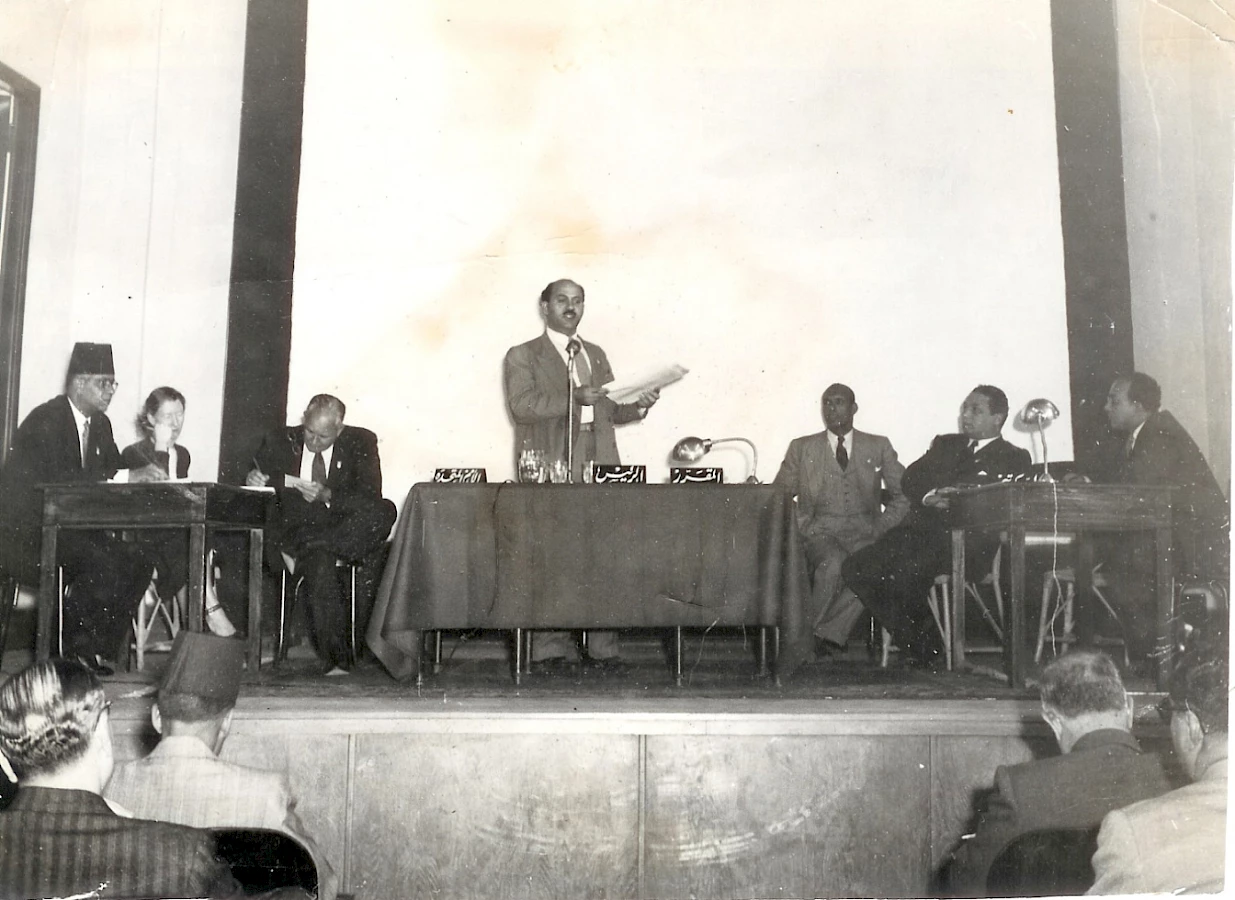
Figure 6. Mohamed Makiya giving a speech at the Arab League (ca. 1960s). Image credit: Mohamed Makiya Archive, courtesy of Aga Khan Documentation Center, MIT Libraries (AKDC@MIT). https://www.archnet.org/collections/123
The Arab Towns Organization (ATO): An (a)political regime
For we have set a policy that the organization works for Arab cities only, and therefore its work is not political and members should stick to that … unfortunately some Arab organizations link politics to their work and transfer conferences to halls to give speeches and lectures. (lines 298–306).
Of course, the contemporary Arab city that came about according to a political agenda does not correspond with the historical Arab city that preceded the Arabo-Islamic. Through both its negotiation of boundaries with bordering empires and its reckoning with previous colonial systems, the contemporary Arab city has effectively questioned its own social order and the distribution of the sensible within it – and this, according to Rancière, is when politics happens.23 Bernard Khoury, who is critical of the secularity of the Arab city and sees its modernity as a failed project, expressed as much through his curation and design of Fundamentalists and other Arab Modernisms at the 14th Venice Biennale of Architecture.24 Shaped like a panopticon, the pavilion afforded the visitor the chance to sit and listen to the national anthems of each Arab country, amongst whose lyrics are included references to the non-secularity of most of those states.25
ATO was established in Kuwait on 15 March 1967 as part of a large network of national movements, both organized and spontaneous, that was then starting to take form, just a couple of weeks before the war began that Khoury identifies as the moment when the project of Arab modernity started to break down.
According to the current secretary general of the organization, ATO was jointly founded by the municipalities of various cities in the Gulf and the Arab world. However, given that its headquarters and funds are both located in Kuwait and the fact that it has always been led by a Kuwaiti, it is hard not to see ATO as a Kuwaiti organization that has appropriated the Arab identity so as to exercise its influence. ATO is currently affiliated with the Development Fund For Arab Cities, Kuwait; the Arab Urban Development Institute (AUDI), Riyadh; the Arab Towns Organization Awards, Doha; the Environment Center for Arab Cities (ECAT), Dubai; the Arab Forum for Information Systems, Amman; and the Foundation for Arab Historic Cities and Heritage, Tunisia.26 Of these five affiliates, the first two are mentioned in the 1979 newspaper article around which this paper is structured (lines 105–27 and 128–44 respectively).27
Then as now, ATO’s clearly stated goal was to maintain the Arabic and Islamic nature of Arab cities (lines 33–36), and it is important to note that in this article as elsewhere, the terms ‘Arab’ and ‘Islamic’ are used interchangeably (lines 33–36, 192–93, 188). It should also be noted that what is discussed therein is not the creation of new Arab cities but rather their preservation (lines 34, 187, 193, 250). This resonates with Abu-Lughod’s claim that Arab city planners were attempting to recreate the past.28 Here, the redistribution of the sensible entails the foregrounding and restoration of a past that the article claims to have been erased by capital-oriented development, city growth and external influences from outside of, and disconnected from, the urban context in question (lines 260–73).
Also mentioned in the article (lines 130–31), the Arab Urban Development Institute, which conducts research and training programmes, has an exhaustive archive/library. This library contains publications by municipalities within the Arab region, many of which can no longer be found in the places they were first published.29
Although it is denied a political aspect in the article, where it appears under the subtitle Away from Politics – a sentiment affirmed by two videos produced by the organization itself, in which it is stated that its apolitical status is why it has been welcomed in all Arab countries (lines 284–311) – the founding of this organization was undoubtedly a political act, at least according to Rancière’s definition of what is politics.30
ATO’s own statement in the article that various Arab cities are now members of the directorial boards of international city organizations serves in a subtle way to imply that they have come to wield global influence (lines 291–95), indicating a redistribution of power and a change to the structure of what Rancière calls the police, meaning the system that orders the various networks in society.31 Moreover, the article then goes on to mention ATO’s overtly political stance of actively excluding Zionists from international planning organizations, displaying a strong solidarity with the Palestinian cause (lines 288–306).
In this section of the paper the Arab city may be seen to have emerged, albeit the term remains somewhat ambiguous. I have shown the contested status of the contemporary Arab city as either secular (or aspiring to be so) or inherently Muslim, and discussed some of the ways in which the Arab city and its discourses are political – sometimes even when it is claimed that they are not.
What Language Does the City Speak?
Also during this year, the Organization will start from the European World as it will organize a scientific symposium in the city of Milan in Italy and the preparations shall be overseen by the Global Cities Institute … The symposium will be devoted to researching traffic and public transport problems in Arab cities, and all studies and lectures will be in the Arabic language (lines 163–70).
In many ways, this insistence on using only Arabic can be seen as part of the self-rediscovery of the Arab city, a reconnection with its pre-colonial identity. In his prelude to Rancière’s The Politics of Aesthetics, Rockhill explains that he has translated the text based on the ‘entire relational system’ of the text, up to and including the wider network of Rancière’s oeuvre.32 Rockhill is right to state that text, language and words are not disconnected objects but are rather connected to historical precedents and social conditions.33 The language we think with influences how we understand and communicate. Each language has its own structure that not only reflects but, for Rancière, also constructs its culture.34 Thus, communicating in Arabic a form of discourse that is usually discussed in other languages can be seen as a mode of dissent, creating a visible and audible identity and a new poetics of knowledge; perhaps even as liberating the mind from a discursive domination that unconsciously functions to intimidate other ways of thinking. A written language also has its own visual identity. According to Nada Shabout, the use of Arabic letters and calligraphy has ‘provided the means for political and visual unity’, including between those of different ethnicities, ‘as well as mediation between the sacred and profane (between the desired afterlife and transient life)’ and continuity between the past, present and future.35 In countries where the language was forbidden during colonial occupation, Arabic has become a strong decolonial tool.
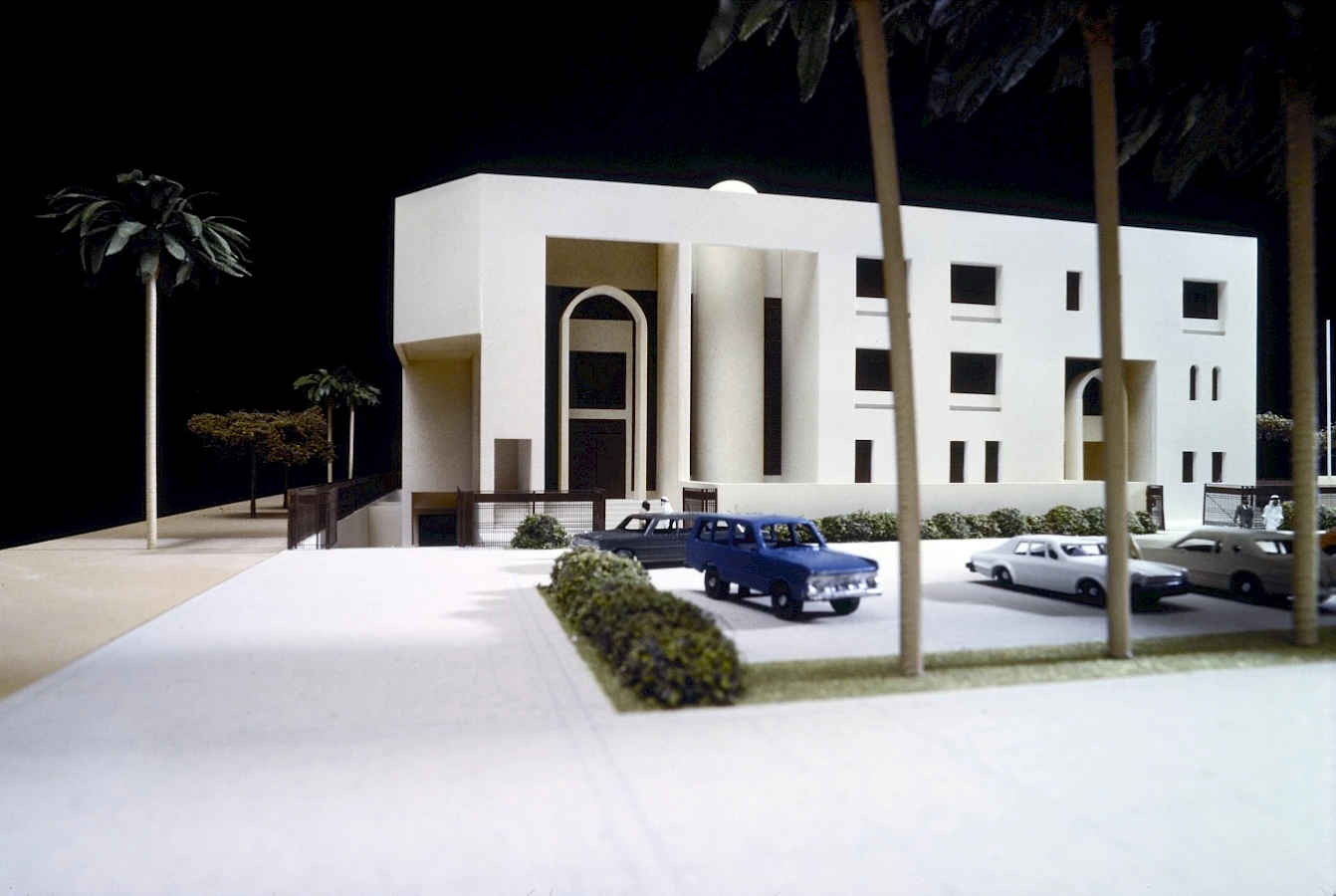
Figure 3. Model of the Arab Towns Organization (ATO) [unbuilt], Kuwait, Mohamed Makiya (September 1983). Image credit: Mohamed Makiya Archive, courtesy of Aga Khan Documentation Center, MIT Libraries (AKDC@MIT). https://www.archnet.org/collections/123
Another form of visual language that is present in the Arab city is that of architecture, with all its functional and symbolic meanings.36 It emerges to reshape the landscape of the city, its streets and the spaces of its civil society, both demos and ethnos. Take for example Mohamed Makiya’s unrealised design for ATO’s headquarters (figure 3). Free of motifs, the proposed building has a simple white façade with some extrusions. However, arches and a dome are deployed, features (arche)typically associated with Arab city architecture, as if to bridge the universalising simplicity of the modern project with the past of the Arab city. The late architect’s son Kanan Makiya labels this, his father’s style, as Post-Islamic Classicism.37 Like many of his generation Mohamed Makiya was politically engaged, and this could have led to his receiving commissions connected to the project of Pan-Arabism (in one image from the 1960s he appears to be giving a speech at the Arab League – see figure 6). Certainly, ATO is not the only organization that adopted a Pan-Arab identity for which Mohamed Makiya proposed projects: he also designed a building for the League of Arab States in Tunis and a headquarters for the Arab Organizations in Kuwait, neither of which were ever built. The architectural model of the latter is white. Edges connect the floor to the roof, wrapping the building to the top and side to side. Its simple façade extrudes inwards to form a shade-giving liwan, a transitional covered portal or vestibule connecting the interior to the outside, upon whose walls windows appear in repetitive bays. A repetition of elements continues throughout the building’s design. Arches of two distinct types serve to contextualise the building: these are no longer the structural elements they once would have been, but cultural motifs. This is not modernity as a turning away from history, culture, and context. Rather, it is a search for the soul of the city, using elements from the past to produce a contextual identity.
Makiya’s (unbuilt) project for the Arab League is another simple building whose modest exterior is without motifs beyond the forms of arches and a dome (see figure 4), though its interior appears more extravagant. Like those of his proposed ATO headquarters, these exterior arches are effectively follies, here for aesthetic reasons. That this is so seems clear to me from an examination of the drawings for this project; no doubt an analysis of his correspondence with the Arab League and his recorded lectures and speeches at the MIT archives would further clarify the issue. In a recently published lecture, Makiya connects the Arab and Islamic aesthetics to environmental and climatic needs, claiming they are inherently more functional, and hence modern.38
Like other intellectuals before them, architects such as Hassan Fathy, Rifat Chadirji, and Mohamed Makiya were among those who returned from the West with ideas of modernity that they then sought ways to contextualise. This is clear not only from their works of architecture but even more so from the publications authored by themselves and others that document their projects. In his foreword to Chadirji’s Concepts and Influences Towards a Regionalized International Architecture, 1952–1978, for example, Robert Venturi reflects on Chadirji’s internal struggle between modernity and contextual relevance.39 Kanan Makiya’s Post-Islamic Classicism: A Visual Essay on the Architecture of Mohamed Makiya defines his father’s work in a similar manner.40 In relation to forms, by comparing these writings with Hassan Fathy’s discussion of his own work in Architecture for the Poor: an Experiment in Rural Egypt it becomes clear that whereas Chadirji and Makiya were primarily in search of a visual identity for them, Fathy’s main preoccupation was with the processes behind their production, in line with Abu-Lughod’s recommendations.41
In addition to its political pursuit of unification, the Arab League created a cultural committee aimed at uniting otherwise culturally diverse Arabs through joint cultural activities. This endeavour was most likely viewed by the youthful and enthusiastic as a radical project of liberation and freedom and by political elites as a chance to increase political gains and domination. Although the Arab identity did not entail religious discrimination, it still excluded non-Arab citizens of Arab countries such as the Iranians in Bahrain, the Amazigh in Algeria, the Southern Sudanese in Sudan, and the Nubians in Sudan and Egypt, in ways that manifested in different forms and at different magnitudes. Arab nationalism also produced a new architectural identity, a new sense of what was considered to be an Arab architecture and, as a result, what could be considered as traditional – this even though, as according to Andraos, the early Arab modernists were not attempting to recreate traditional Arab and/or Islamic architecture but were rather engaged in building functional architecture inspired by the ancient civilisations of their respective countries, as evidenced in the periodicals they produced.42
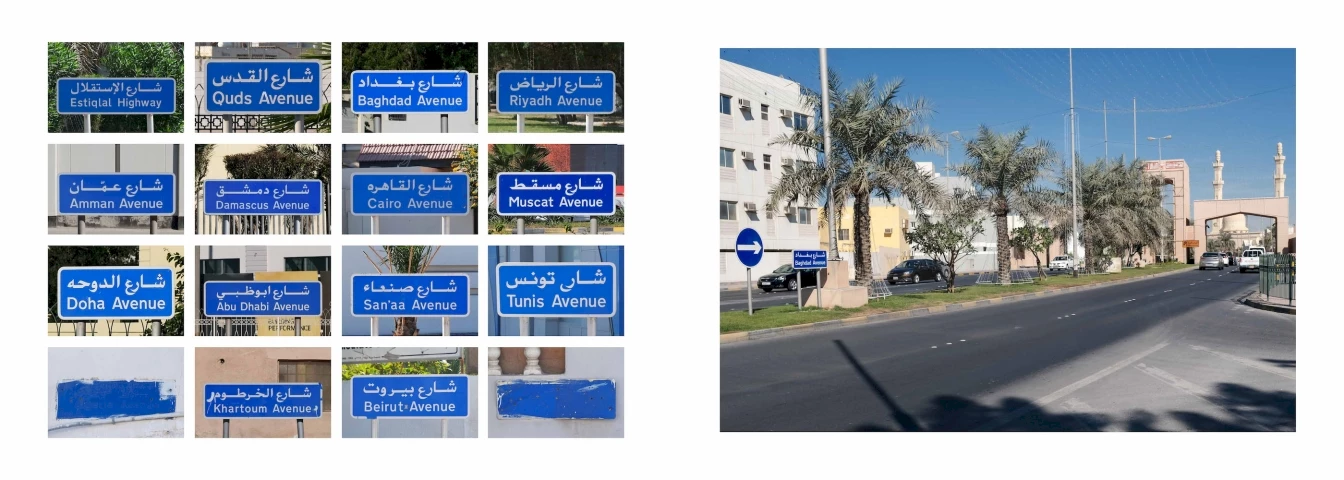
Figure 7. Streets named after Arab capitals in Isa Town, Bahrain. The streets are ordered according to their width and length, the largest on the upper left, and the smallest on the lower right. The Gateway to the town was designed by Mohamed Makiya. Image credit: Suha Hasan, 2021.
The Modern Arab City that Manifested
The design of the city must be compatible with the customs of the citizens, their traditions, environment, religion and needs … and this all gives in the end a special character to the city … But unfortunately, the rapid growth of Arab cities did not consider these issues, especially if we take into account that the technical planners are from foreign companies which are ignorant of our traditions and they also aim to achieve the greatest amount of profit … Unfortunately, this matter is reflected on the reality of our cities that have thus fundamentally lost their personality (lines 256–67).
‘The city has lost its character’ is the title chosen by the journalist author of this article featuring ATO. Published at a time when the region was soon to find itself subject to a rising Islamic revival and the advancement of political Islam, the article itself seems to be characterised by an urgency to retrieve said character, whose loss it attributes to the foreign companies that were commissioned to design the cities in question. In hindsight, it may also be attributed to increasing globalisation and the rise of capitalism that has infiltrated every aspect of life, motivating architects to build primarily for profit rather than to produce change. Andraos writes of architects’ ‘powerlessness in the face of global capital but also the continuing capacity of buildings to embody ideas, to produce content, to shape context’.43 So if, in the past, the introduction into the city of a new-old aesthetic was intended to serve a political Pan-Arab project, what is the city communicating today? Does capital, like politics and aesthetics, have a language?
In this paper, I have addressed the rise of a post-modern aesthetic in Arab city architecture and planning by analysing a newspaper article featuring ATO that links to wider issues. I have used the work of Rancière as a conceptual and organizing framework, connecting the rise of urban aesthetics with politics, dissent, and the redistribution of the sensible, leading to the emergence of a new poetics of knowledge. No mere object of study, the city itself can be seen as a subject with the agency to produce a new body of knowledge through the new-found identity it embraced out of a desire for self-ownership and liberation. It is therefore ironic that this project has tended to reproduce Orientalist ideas. More recently it seems to have been diluted by economically motivated development and the rise of nationalism within each country. However, the aesthetic and architectural search for, and reimagination of, the Arab city is an ongoing process in which new moments of dissensus continue to emerge.
The early years after independence led to the production of a new aesthetics that embodied the solidarity of a socialist Pan-Arab movement as well as the political agendas of regional governments. It has been noted that the terms ‘Arab’ and ‘Islamic’ are sometimes used interchangeably in this context, although they are not identical and can sometimes be discordant with one another. The former is linked to a secular political project that looks forwards to a united Arab future, whilst the latter is connected to a politico-religious project demanding a return to a united Muslim past. When discussing design identities, however, the terms can rightly be conjoined to describe elements of an aesthetics that seeks symbolically to express a place’s uniqueness, born in reaction to the colonial times that preceded it and the forms of modernity imposed by colonial institutions.
With thanks to Dr Julian Brigstocke and Dr Günter Gassner, organizers of the ‘Spaces and Politics of Aesthetics’ Social and Cultural Geography Research Group Symposium at Cardiff University in 2019; and to Prof. Maria Hellström Reimer, organizer of the ‘Space, Politics and Aesthetics’ seminar and PhD course at Malmö University, for their readings of an earlier version of this article.
See Gaston Bachelard, The Poetics of Space, 1958 (trans. Maria Jolas), Boston: Beacon Press, 1994.
See Mustafa Dikeç, Space, Politics and Aesthetics, Edinburgh: Edinburgh University Press, 2015.
Jacques Rancière, Aesthetics and its Discontents (trans. Steven Corcoran), Cambridge: Polity, 2009, p. 97.
See Annette Hastings, ‘Connecting Linguistic Structures and Social Practices: a Discursive Approach to Social Policy Analysis’, Journal of Social Policy, vol. 27, no. 2, 1998, pp. 191–211.
See Aníbal Quijano, ‘Coloniality and modernity/rationality’, Cultural Studies vol. 21, no. 2–3, 2007, pp. 168–78; Walter D. Mignolo, ‘Delinking: The rhetoric of modernity, the logic of coloniality and the grammar of de-coloniality’, Cultural Studies vol. 21, no. 2–3, 2007, pp. 449–514.
See Valentin Seidler, ‘Institutional Copying in the 20th Century: the Role of 14,000 British Colonial Officers’, Journal of Contextual Economics, vol. 137, Berlin: Duncker & Humblot, 2017, pp. 93–120.
Ibid.
See Walter D. Mignolo, ‘Delinking: The rhetoric of modernity, the logic of coloniality and the grammar of de-coloniality’, Cultural Studies vol. 21, no. 2–3, 2007, pp. 449–514.
Achille Mbembe, ‘The Power of the Archive and its Limits’, Refiguring the Archive (ed. Carolyn Hamilton, Verne Harris, Jane Taylor, Michele Pickover, Graeme Reid, Razia Saleh), Dordrecht: Springer, 2002, pp. 19–27.
These conditions appear in various places such as Palestine, Egypt, Algeria, and Lebanon. See Rona Sela, ‘The Genealogy of Colonial Plunder and Erasure – Israel’s Control over Palestinian archives’, Social Semiotics vol. 28, no. 2, 2018, pp. 201–29; Marwan Ghandour and Mona Fawaz, ‘Spatial erasure: Reconstruction Projects in Beirut’, ArtEast Quarterly, Spring 2010; René Boer, ‘Erasing the Remnants of a Revolution’, Failed Architecture, 2015 (accessed 11 November 2021).
See Achille Mbembe, ‘The Power of the Archive and its Limits’.
See Benedict Anderson, Imagined Communities: Reflections on the Origin and Spread of Nationalism, London: Verso, 2006.
See report FO 371/45241 held at the National Archives in London; see also A.L. Burdett, The Arab League: 1944–1946, vol. 4, Cambridge: Archive Editions, 1995.
Khaled Fahmy, Mehmed Ali: from Ottoman Governor to Ruler of Egypt, New York: Simon & Schuster, 2012.
See Albert Hourani, Arabic Thought in the Liberal Age 1798–1939, Cambridge: Cambridge University Press, 1983; Talal Al-Rashoud, ‘Modern Education and Arab Nationalism in Kuwait 1911–1961’, unpublished doctoral thesis, London: SOAS University of London, 2017.
See Rifa'a al-Tahtawi, Takhlees Al-Ibriz Fi-Talkhis Bariz (translated as A Paris Profile or An Imam’s Account of Paris), Cairo: Hindawi Foundation for Education and Culture, 2012.
See Janet Abu-Lughod, ‘The Islamic City – Historic Myth, Islamic Essence, and Contemporary Relevance’, International Journal of Middle East Studies, vol. 19, no. 2, pp. 155–76.
See André Raymond, ‘Islamic city, Arab City: Orientalist Myths and Recent Views’, British Journal of Middle Eastern Studies, vol. 21, no. 1, pp. 3–18, 1994.
Ibid.
For the cover of Al Emara, vol. 3, nos. 3 and 4, 1941, see archnet.org (accessed 27 November 2021).
Modern Indignation (2018), Egypt’s first (and award-winning) entry into the London Design Biennale, focused on Al Emara’s attempts to engage with a modernity that extended beyond the borders of Egypt and into Europe.
See Jacques Rancière, ‘The thinking of dissensus: politics and aesthetics’, Reading Rancière (ed. Paul Bowman and Richard Stamp), New York: Continuum, 2011, pp. 1–17.
Fundamentalists and Other Arab Modernisms, Kingdom of Bahrain’s Pavilion, 14th Venice Biennale of Architecture, 2014.
Conversation with Bernard Khoury, 27 April 2020, Virtual Space, Mawane, mawane.org (accessed 27 November 2021).
Interview with Nuha Eltinay, former director of the Arab Urban Development Institute, 27 April 2020.
According to this article, the Development Fund For Arab Cities was created at the instigation of the Head of the Bahrain Municipality Abdullah bin Khalid Al Khalifa with the aim of supporting Arab cities through the provision of loans (lines 112–16). The Arab Urban Development Institute was established to provide professional development enabling recipients to better respond to the needs of their city (lines 143–44).
Janet Abu-Lughod, ‘The Islamic City’.
Interview with Nuha Eltinay, 27 April 2020. Among those of the institute’s archival holdings in which the Arab city’s heritage and identity are mentioned, I noted one publication in which the Mosque and the Arab city were discussed but no mention was made of any of the other religious buildings present – another instance where the Arab and Islamic have been seen to intersect.
See videos ATO1 and ATO2 hosted on the Arab Towns Organization’s YouTube channel (accessed 22 November 2021).
See Mustafa Dikeç, Space, Politics and Aesthetics, Edinburgh: Edinburgh University Press, 2015.
Gabriel Rockhill, prelude to Jacques Rancière, The Politics of Aesthetics, (trans. and ed. Gabriel Rockhill), New York: Continuum, 2004.
Ibid.
See Jacques Rancière, The Names of History: On the Poetics of Knowledge (trans. Hassan Melehy), Minnesota: University of Minnesota, 1994.
Nada M. Shabout, ‘The Arabic Connection in Articulating North African Modernity in Art’, South Atlantic Quarterly, vol. 109, no. 3, p. 534, 2010.
See Umberto Eco, ‘Function and Sign: Semiotics of Architecture’, Signs, Symbols and Architecture (ed. Geoffrey Broadbent, Richard Bunt, Charles Jencks), Chichester: John Wiley & Sons, 1980.
See Kanan Makiya, Post-Islamic Classicism: A Visual Essay on the Architecture of Mohamed Makiya, London: Al Saqi, 1990.
Mohamed Makiya, ‘Appendix II: Lecture to Royal Institute of British Architects, 31 January 1984’, in Karen Dabrowska, Mohamed Makiya: A Modern Architect Renewing Islamic Tradition, London: Saqi Books, 2021.
See Robert Venturi’s foreword to Rifat Chadirji, Concepts and Influences Towards a Regionalized International Architecture 1952–1978, London: Routledge, 1986.
Kanan Makiya, Post-Islamic Classicism.
See Hassan Fathy, Architecture for the Poor: An Experiment in Rural Egypt, Chicago: University of Chicago Press, 2010; Janet Abu-Lughod, ‘The Islamic City’.
Amale Andraos, ‘The Arab City’.
Amale Andraos, ‘The Arab City’.
The views and opinions published here mirror the principles of academic freedom and do not necessarily reflect the views or positions of the L'Internationale confederation and its members.